 Written by Mike Price, OT
Written by Mike Price, OT
An accessible inclusive playground fosters an atmosphere of trust and celebrates diversity. By ensuring everyone can participate in playground activities - regardless of abilities - everyone is welcome to enjoy the same space. An accessible inclusive playground helps build bridges and develop connections between people. Rather than being separate “special needs” spaces, these playgrounds deliver quality, balanced, and meaningful play opportunities for all children.
An accessible playground, also referred to sometimes as an adaptive playground, provides access to playground equipment for children with or without disabilities. An accessible playground has unobstructed routes to the play space and connecting play equipment, ground-level play components, ramps with handrails for much of the elevated play equipment, and safety surfacing for wheelchair traction. An accessible playground ensures every child playing there can freely travel on smooth ramps and paths, have grab bars within reach, and be able to safely move from one piece of equipment to another.
An inclusive playground addresses the needs of children with sensory issues. This includes equipment for sensory input seekers that has tactile elements to it with different textures, sounds, and movements. It also includes creating a quiet area for kids who are overstimulated and need to calm their sensory systems in a comfy, cozy space. An inclusive playground welcomes kids of all developmental stages to enjoy a play space on their own terms, addressing their own needs for comfort as well as recreation.
Just about everyone enjoys swinging. But even more than being universally fun, swinging supports sensory, muscle, and social development. By fostering balance, recognition of where the body is in space, gross and fine motor skills, coordination, connecting speed and direction, playground swings are an important tool in every child’s development. You’ll find our list of 5 Best Swing Seats That Are Handicap Friendly features handicap-accessible playground equipment that makes the benefit of swinging available to everyone.
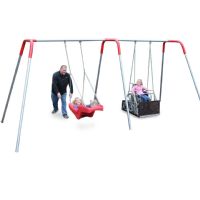 | Two Bay ADA Compliant Wheelchair Swing Set with Swings View Product |
One of the most physically challenging tasks of a caregiver for a special needs child is lifting a child with mobility challenges who cannot independently transfer themselves. A wheelchair-accessible swing allows a child’s wheelchair to be rolled onto a platform that swings. The child doesn’t have to be lifted out of their wheelchair, into a swing, then out of the swing, and back to their wheelchair. They get the benefits of swinging without having to leave their seat.
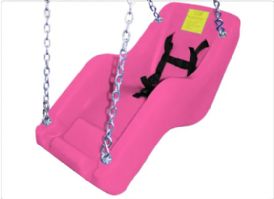 | JennSwing Special Needs Pediatric Swing View Product |
For children who don’t have the strength, balance, and coordination to maintain an upright position independently while on a swing, special needs swings provide the support they need to be comfortable and safe while enjoying whizzing through the air on a swing. Perhaps they need an angled seat or head, neck, back, and/or leg support or safety straps to keep them securely seated. A special needs swing ensures kids with disabilities are not deprived of the benefits and fun of swinging.
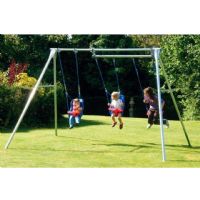 | The Swung No Push Swing - Triple Swung Package View Product |
Pushing a swing from behind doesn’t allow for eye contact and social connection that so many kids with special needs benefit from and find reassuring as well as stimulating. A no-push swing allows the swinging of an able-bodied person on one swing to propel the swinging motion on an attached special needs swing. With this type of swing, a child with special needs can engage with the person providing the swinging motion without any pushing from behind required.
Interactive activity panels teach elements like rhythm, sound, motion, colors, and fine and gross motor skills. This inclusive playground equipment allows kids to express themselves and explore their space through activities that support imaginative play.
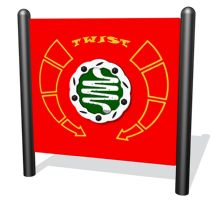 | Interactive Free-Standing Panels Playground Equipment View Product |
High-touch sensory activity panels teach lessons in cause and effect and improve hand-eye coordination while attracting children to play together. These interactive panels can utilize music, colors, drums, chimes, and textures to engage and stimulate the imagination while supporting the development of cognitive, tactile, language, sensory/motor, and social skills.
Developing agility and dexterity, activity panels that allow kids to play games, solve puzzles, and create art all contribute to enhanced motor skills. Requiring children to push buttons, adjust knobs and interact with a writing surface keeps children interested and engaged while they are learning.
Language activity panels, also known as linguistics activity panels, promote interactive play and language skills. Usually featuring the alphabet in traditional or sign language, these activity panels support language development through playground activities.
 | Interactive Free-Standing Panels Playground Equipment View Product |
Wheelchair-accessible activity panels, also called Reach Panels, allow kids in wheelchairs to roll up and under the panels and enjoy the activities positioned within reach. They require pathways that are easily navigated by wheeled mobility devices and are designed for kids to be able to get close enough to them to be able to interact with any and every element of their choosing.
Play structures transform play space into everything from pirate ships to airplanes to castles in the imaginations of the kids who use them. Removing physical and social barriers to erect a handicap-accessible playground for multiple visitors to enjoy at once allows these structures to fuel the imagination and sense of camaraderie of every child who enters the space.
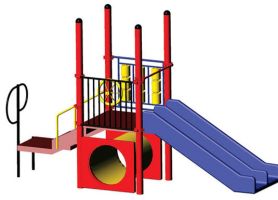 | Jeremy Wheelchair Accessible Play Fort with Double Slide View Product |
Wheelchair-accessible play structures minimize hazards and maximize engagement opportunities for wheelchair users. Smooth surfacing allows for ease of movement, width accommodations for mobility equipment, handrails for gripping, and activities that allow for a wheelchair to get close to manipulatives that are at a reachable height make wheelchair accessible modular play structures a conduit for imagination and development.
.jpg&newwidth=365&maxheight=200) | Bobbie Playground Tunnel Fort with Activity Panels View Product |
From towers to tunnels, modular play structures help the children who play on them to build strength, coordination, balance, fine motor skills, gross motor skills, and agility. The addition of multisensory stimulation from textures, movement, colors, and sound can satisfy sensory seekers, while having a quiet enclosed space where an overstimulated child can relax and get calm makes a visit to the playground more enjoyable and supportive for many kids with sensory processing issues.
Getting onto a playground is the first step for a special needs child. Once there, however, there are many other factors to consider that truly make a space fully accessible.
~1.jpg&newwidth=365&maxheight=200) | ADA Playground Border Ramp View Product |
Many playgrounds have short borders around them to outline the play space and keep any surface cover, like wood chips, corralled and off adjacent walkways. Playground border ramps are installed up and over the border to allow kids in wheelchairs or using other mobility devices to enter the playground without needing to step over the play space border.
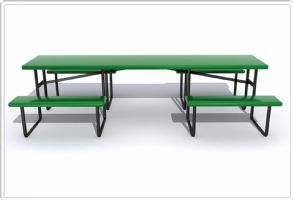 | Wheelchair Accessible Picnic Table with Center Entry View Product |
Picnicking is a fun addition to any visit to the park. Even if the playground area is wheelchair accessible, if the picnic area is not equally accessible, the experience is diminished for a wheelchair user. A picnic table specifically designed to include a user in a wheelchair creates a comfortable space for the child with special needs and everyone they share a table with.
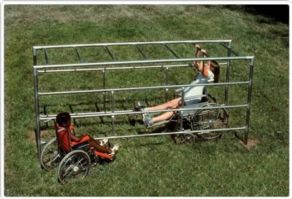 | Wheel Thru Arcade Playground Equipment View Product |
Monkey bars are a popular staple of playgrounds, helping build upper body strength and hand-eye coordination while having fun. Wheel-thru monkey bars make sure more kids can enjoy this playground equipment, as they reach up to grab the bars and move themselves down the row in their wheelchairs.
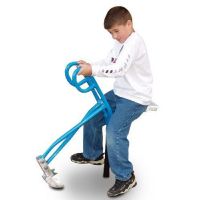 | Playground Sand Box Diggers View Product |
Sand diggers have a seat a child sits in while managing the hand controls of the digger. A wheelchair-accessible sand digger doesn’t have the seat built-in, so a kid in a wheelchair can roll into position and use the sand digger’s hand controls just like any other child.
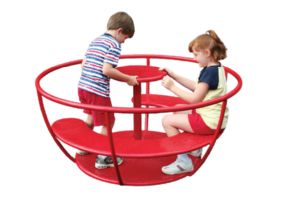 | Tea Cup Merry Go Round View Product |
An inclusive merry-go-round can be used by children of all abilities. It encourages collaboration and social interaction while helping develop fine motor skills like gripping and grasping, vestibular skills like balance, gross motor skills using large muscle groups to propel the equipment, plus it’s just fun for all!
Accessible and inclusive playground equipment is available in a wide range of designs, activities, and level of investment. Ensuring you are providing an enriching experience for all will create a positive environment of acceptance and fun no matter where the accessible playground is located.
Although playground equipment and facilities constructed or altered before March 15, 2012, aren’t required to comply with the 2010 ADA Standards for Accessible Design, every playground now is required to offer a range of play experiences to children of varying abilities.
When all kids, whether or not they’re in a wheelchair, can enter and exit equipment or structures at the ground level, they can play together regardless of ability or disability. Not being able to enter a play area because it is located off the ground with no ramp for accessibility robs kids in wheelchairs of having the same play experience as their peers.
Playground equipment is no small investment. Fortunately, play systems can be purchased one piece at a time, and can be added to as future funds become available. Keep in mind organizations and foundations have money available for playgrounds, outdoor fitness areas, and other recreation initiatives. Researching these opportunities could connect you with additional funding resources.
There are a lot of options to choose from when creating an accessible inclusive playground. Matching up the handicap-accessible playground equipment with the needs of everyone who will be using the space can be an overwhelming task. Carefully assess the needs of the children the playground will serve, from their ages and developmental stages to their physical disabilities and other special needs challenges. No matter what equipment you choose, you want it to be a safe, fun, welcoming place for all.
Not every piece of playground equipment will appeal to every child. Not every able-bodied child is going to want to engage with the activities designed to include kids with special needs, and there are some pieces of equipment that kids with special needs just might not be able to operate or enjoy. But the play space should integrate all equipment and activities in the same area, so as not to create segregated play spaces for disabled and non-disabled visitors. The point of building an ADA-compliant play structure is so children with disabilities can play and socialize with peers without being excluded.
Ordering equipment is just the first step. Putting it together and installing it correctly must be considered when creating an adaptive playground. Liability dictates the space must be assembled so it is secure and stable. User manuals are available for review when shopping online to assess the level of difficulty for assembly and installation.
A: An ADA-accessible playground provides a range of play experiences to children of varying abilities. It must include: An accessible path from the building or parking lot to the edge of the play area, an accessible path from the edge of the play area to the play equipment, and prescribed surfacing. Children must be able to access the play equipment by either moving out of their wheelchair or another mobility device onto the play structure or by direct access while using their mobility devices. This can be through a transfer station or a ramp.
A: A quick online search for playground funding opportunities reveals a long list of organizations that have funds to contribute to playground construction. Some examples of these include: Playground Grants for Non Profits, Government Grants, Health Related Grants, and Private Company Grants.
A: Playgrounds that meet the needs of all visitors will have ramps, inclusive slides, ground-level play activities, sensory activities, inclusive swings, and wheelchair-accessible equipment.
A: Rehabmart has an extensive catalog of accessible and inclusive playground equipment, with several links in this article noting the best pieces of equipment in multiple categories.
A: No, slides are not required to be part of a playground.
A: An adaptive playground, sometimes called an accessible playground, means the playground has play equipment that accommodates kids with disabilities.
A: They can range from about $200 to about $2000, depending on what disability is being accommodated.
Playgrounds are meant to be enjoyed by all who visit them, not just typical children who are able-bodied, but ALL children. Making playground equipment and activities accessible and inclusive for all kids brings children together to collaborate, enjoy, and grow in a space that welcomes all kids to a safe and fun place to play. With products supporting mobility from sensory processing to therapy, Rehabmart’s Special Needs Store features a comprehensive catalog to create an environment that allows every child to grow and flourish.
A lot of work goes into creating a play space! The most important things to keep in mind - aside from safety - are clearing the way to get to and around the play space, providing activities that appeal to kids of all abilities, and ensuring kids of all abilities can engage with the equipment in fun ways that help develop their physical and social skills.
Thank you for your time in reviewing this information on creating an accessible inclusive playground. Visit Caregiver University for buying guides, product reviews, and other articles that equip caregivers to make informed decisions.

Co-Founder of Rehabmart and an Occupational Therapist since 1993. Mike has spent his professional career working in multiple areas of Occupational Therapy, including pediatrics, geriatrics, hand therapy, ergonomics and inpatient / outpatient rehabilitation. Mike enjoys writing articles that help people solve complex therapeutic problems and make better product choices.